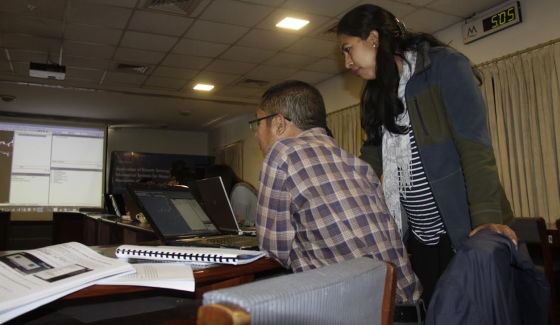This site uses cookies, as explained in our terms of use. If you consent, please close this message and continue to use this site.
 Finu Shrestha, Research Associate GIS helping a training participant during the hands on exercise
Photo: Chimi Seldon/ICIMOD
Finu Shrestha, Research Associate GIS helping a training participant during the hands on exercise
Photo: Chimi Seldon/ICIMOD
The International Centre for Integrated Mountain Development (ICIMOD), through its Cryosphere Initiative, recently organized a five-day training on using remote sensing (RS) and geographic information system (GIS) to map and monitor glaciers in the Hindu Kush Himalaya (HKH).
Nineteen participants consisting of students and professionals from ICIMOD’s partners in Bhutan, Nepal and Pakistan attended the training organized at the ICIMOD headquarters in Kathmandu, Nepal, in March 2017.
The training aims to build the capacities of national partners on the use of RS and GIS for glacier mapping and monitoring, and it was the 11th of its kind. In addition to Nepal, ICIMOD has organized this training in Pakistan, Myanmar, Bhutan and Afghanistan.
Such trainings help build and enhance the capacities of professionals working in water resources research and management in relation to using RS and GIS for mapping and monitoring glaciers and glacial lakes. Events such as these also open up avenues for research collaborations with and between relevant implementing partners in the region.
As a follow-up to the training programme, six professionals from Tribhuvan University in Nepal will be getting on-the-job training at ICIMOD for the duration of two months. The professional mentoring they will receive while at ICIMOD will help them further develop their RS and GIS skills, and contribute to glacier data generation in the HKH.
Through its various capacity building activities, the goal of the Cryosphere Initiative is that the HKH will, in the long run, have an increased number of experts who can independently carry out long-term glacier monitoring.
ICIMOD works in the HKH with eight regional member countries- Afghanistan, Bangladesh, Bhutan, China, India, Myanmar, Nepal, and Pakistan. The Cryosphere initiative of ICIMOD is supported by the Government of Norway.
The HKH has the largest glacier area besides the two polar regions and are the source of ten large Asian river systems, providing water to 1.3 billion people, about a fifth of World’s population.
The article was published at Glacier Hub on 9 April 2017.
Stay up to date on what’s happening around the HKH with our most recent publications and find out how you can help by subscribing to our mailing list.
Sign Up